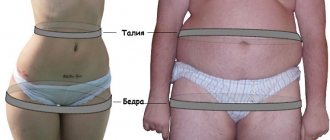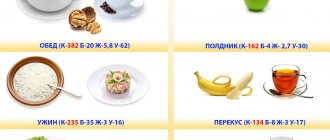Not a good sign
Its circumference is more than 102 cm - this is a clear sign of abdominal obesity. This type of fat in the human body is perhaps the most dangerous. Due to excessive obesity, type 2 diabetes mellitus and cardiovascular diseases can develop. Decreased insulin activity increases the release of free fatty acids, which contributes to the process of joint destruction. The situation is worsened by the fact that due to increased body weight, the load on the human skeleton increases.
If this happens, you should not think that the situation is hopeless. Everything can be corrected. This is something worth striving for. After all, even a small decrease in waist circumference by just 4 cm is equivalent to the health benefits obtained from reducing body weight by 5-10%. Even such small progress improves carbohydrate and fat metabolism in the body, which helps lower blood pressure.
Discussion
- The present study demonstrates that WHtR is the best predictor of metabolic syndrome and its components in both sexes.
- WHtR has the greatest prognostic value for the diagnosis of most components of the metabolic syndrome: elevated glucose levels
- blood pressure
- triglycerides
- decreased HDL levels
- Central visceral adipose tissue mass is directly associated with the risk of cardiovascular disease and metabolic syndrome, in contrast to subcutaneous adipose tissue mass.
- Waist circumference closely correlates with reference methods for determining fat content (CT, MRI): it is a more informative marker of metabolic syndrome than BMI.
- This is why waist circumference must be correlated with height.
- The present study compares WHtR and BMI indices with body composition.
- Body composition analyzers, such as bioimpedance analysis or DEXA, measure indices of fat and fat-free mass, which include lean mass and bone mineral composition.
- A number of studies have demonstrated an inverse relationship: an increase in lean mass leads to an increased risk of developing insulin resistance and metabolic syndrome.
- Therefore, in clinical practice it is recommended to use the thesis: “your waist should be less than half your height.”
- The average AUROC values for identifying metabolic syndrome are 0.704, 0.693. and 0.670 for WHtR, waist circumference and BMI, respectively.
- WHtR has the highest AUROC values. Next in terms of forecasting efficiency were waist circumference and BMI.
- Approximately 57.7% of the full cohort were excluded from the study cohort.
- The present study has a number of limitations. Cross-sectional nature and ethnic differences were not assessed.
- This study has the potential for inaccurate or dishonest survey responses.
Determination of waist norm
So, the first thing to do is measure your waist circumference. It's important to do it right. The measurement is carried out with a regular centimeter tape. The girth for measurement is taken not at the level of the navel, but in the middle between the bottom line of the lower rib and the top point of the pelvic bone. Measurements are recorded as you exhale and taken twice. If the measurement values differ by 1 cm, the average result is taken.
What waist circumference should men have? Although an adjustment is made for body height, 102 cm, as noted earlier, is already a problem. We can say that the upper limit should be 94 cm. If a man’s waist exceeds 96 cm, then there is cause for concern. Then the person needs to take action to take control of the situation as soon as possible.
To understand in detail what waist size men should have, you need to consider the waist-height index. In short, this index is an indicator that characterizes a person’s physique. The body mass index, which is often used to check the correspondence of weight to height, does not reflect the situation with the physique as correctly as compared to the waist-height index. The latter is based not on weight, but on waist circumference. Because weight characterizes not only the volume of fat, but consists of different components. This indicator, by the way, is used by athletes, including professional ones. Men actively involved in bodybuilding regularly check their waist size before and after training, as well as during the process. It is very important for them to have a low fat content with a high muscle content. But the question of what a man’s waist should be is relevant not only for athletes. After all, which guy wouldn’t want to have a beautiful figure, without excess belly fat? And who needs health problems?
results
Baseline characteristics of participants
- The average age of participants was 48 (36-62) years for men (n=6875)
- 48 (36-61) years for women (n=9090)
- Level of education for men: primary school - 1,263 (18.4%)
- secondary school - 871 (12.7%)
- high school - 2,471 (35.9%)
- college and further education 2,231 (32.5%)
- primary school - 3033 (33.4%)
Thus, the level of education was higher in men than in women (p < 0.001).
- Men had higher body measurements, including waist circumference, WHtR, BMI, lean mass index, fat mass index, trunk fat mass index, skeletal muscle mass index, and bone mineral composition, than women.
- Also, men had clearly higher levels of blood pressure, glucose, triglycerides, and lower HDL levels.
- The prevalence of alcohol consumption, smoking, and chronic kidney disease was higher among the male group of study participants.
Comparison of predictors of metabolic syndrome among body indices
- Body index studies were conducted using AUROC: Waist-to-height ratio (WHtR) index has the highest area under the curve (AUC): men: 0.823, 95% CI 814-0.832
- women: 0.870, 95% CI 0.863-0.877)
- Sensitivity for detecting metabolic syndrome using WHtR: 74.0% for men,
- 75.8% for men,
- glucose level
Presence of metabolic syndrome according to the WHtR indicator
- According to the level of WHtR, participants were divided into 4 groups.
- For the male group the following were: Q1 ≤0.4603;
- Q2 0.4604-0.4981;
- Q3 0.4982-0.5343;
- Q4 ≥ 0.5344.
- Q1≤0.4520;
- Q2, Q3 and Q4 had a higher risk of metabolic syndrome compared to group Q1: 4.0 (95% CI 3.1-5.2), 9.6 (95% CI 7.5-12.3), and 36.1 (95% CI 28.0-46.4) times, respectively.
- Q2, Q3 and Q4 the risk of metabolic syndrome compared to the Q1 group is higher: 4.3 (95% CI 3.1-6.0), 18.0 (95% CI 13.3-24.5), and 58.5 (95% CI 42.9-79.9) times increased.
Index norm for men
What waist size should men have for a particular height? Using the waist/height ratio mentioned above, a guy will be able to determine whether his waist size is within the normal range. For this, in addition to a measuring tape, you will also need a calculator. Here you will have to deal with specific numbers. The data obtained from the measurement in centimeters must be divided by the height in centimeters. The number that comes out as a result of division is the “waist-height” index. How to use these numbers? You can write down the following values for yourself, of course, they differ from the norms for women: the index norm for men is 0.43-0.53. With an indicator of 0.54 and above, a man can be “diagnosed” as overweight and obese. An indicator of 0.58 means severe obesity. But you should not think that the lower these numbers, the better. For example, an indicator equal to or less than 0.42 may mean severe thinness. A value of 0.35 means pathological thinness and underweight in a man. Therefore, there is a lower limit for this indicator (0.42).
WHAT SHOULD BE THE WAIST OF MEN?
The ideal male waist size should be less than 94 cm.
Waist size for men: table
| Health risks | Circle |
| Short | 93 cm and less |
| Intermediate | 94‒101 cm |
| High | 102 cm and above |
- Waist-to-hip ratio in men
The simplest self-diagnosis method that can be used at home is to determine the waist-to-hip ratio. To do this, a man needs to measure the girth of his abdomen (on an empty stomach, it is better to do this always at the same time) in a relaxed state, approximately at the level of the navel. Then measure your hips at their widest point. Next you need to divide the first result by the second:
Waist (in cm) / Hips (in cm) = Ratio
If the result obtained after division is above 0.95, a man’s chances of heart attack and stroke increase. For example, a man’s waist is 80 cm, his hips are 95 cm. The ratio will be: 80 divided by 95 = 0.84 - the norm.
Your waist-to-hip ratio is a useful way to monitor your health. But many experts are turning to an even simpler technique: measuring just the waist circumference. Because this method involves one measurement instead of two, it is considered more accurate and simpler.
- Waist circumference
To correctly measure your waist circumference, a man needs to take off his shoes and stand with his feet together. The belly should be bare. Relax and exhale. It is advisable to use an unstretched soft measuring tape. You need to hold it straight, without pulling. The result obtained is recorded to the nearest millimeter.
Normally, the maximum waist size should be no more than 94 cm.
Organs and parts of the body can be of different shapes and sizes, so there is no single table for all, which would indicate the standard waist and hip sizes for men. However, there is a healthy range for weight, waist circumference and hip circumference. These numbers are used to determine the percentage of body fat and the presence of excess weight.
- Height, weight and BMI of a man
When scientists realized that it was not so much body weight that mattered, but the amount of fat, standards for assessing obesity began to change. Nevertheless, measuring body mass index (BMI) remains one of the main methods for diagnosing overweight and obesity. To calculate it, weight in kg must be divided by height in meters squared. For example, a man’s weight is 80 kg, height is 175 cm. BMI = 80 / (1.75 * 1.75). The body mass index will be 26.1, which is above normal.
A BMI between 18.5 and 24.9 is considered normal. Anything above 24.9 indicates overweight. A figure below 18.5 indicates underweight.
BMI is considered to be a better measure of body fat than a test that measures the thickness of the skin on the abdomen. However, while being an official standard, the body mass index also has several disadvantages. First, athletes with a lot of muscle may have a BMI that is outside the normal range, but they will have little body fat. On the other hand, body mass index may not accurately reflect fat content in older people who have lost a significant amount of muscle mass. But the main disadvantage of the method is that BMI reflects the total volume of fat without taking into account how it is distributed in the body.
- Body mass index versus waist circumference
BMI is a more complex test, but self-measuring your waist is often done incorrectly. Therefore, doctors advise men to take both measurements. “BMI provides an estimate of overall body weight, and waist measurement is a good predictor of visceral abdominal fat and the risk of obesity-related diseases,” say researchers from Harvard University.
- Waist to height ratio
Men who are concerned about their heart health are also advised to calculate their waist-to-height ratio (WHTR). To do this, the abdominal circumference in cm is divided by the height in cm. This calculation provides additional information about the state of health.
A result in the range from 0.43 to 0.52 is considered normal.
According to these calculations, the average man's waist circumference should be from 76 to 91 cm. For example, if the height is 176 cm and the waist is 82, the result will be 0.46 and within the normal range (82 cm / 176 cm = 0.46).
Specific examples
Let's look at specific situations. For example, what should the waist be for men with a height of 180 cm? Suppose the waist circumference is 90 cm. Then 90 must be divided by 180. The action of 90 ÷ 180 gives a total of 0.50. The result is good, as it does not exceed the upper limit (0.53). In general, for men who are 180 cm tall, the permissible waist circumference limits are 77.4-95.4 cm.
Now let’s figure out what the waist should be for men with a height of 178 cm. A guy of this height should have it in the range from 76.54 cm to 94.34 cm. What should be the waist for men with a height of 185 cm? For this height, the corresponding dimensions will be 79.55 at the lower limit, and the upper limit will be 98.05 cm.
What is the normal waist size for a short man? More on this later. The same small calculation will help you find out what the waist should be for men with a height of 176 cm. By multiplying the numbers 0.43 and 0.53 (the index mentioned above) by 176 (height), we arrive at 75.68 cm (lower limit) and 93.28 cm (upper limit). It turns out that if a man 185 cm tall has a waist circumference of, for example, 96 cm, then everything is normal. That is, this does not cause much concern. But if a man with a height of 176 cm, measuring his waist, saw that the centimeter closed only at the number 96, for him this is already a clear overkill.
We figured out in detail what the waist circumference should be for men of different heights. Now the guys clearly understand how they are doing in this regard: everything is normal or there are serious signals. If measurements show that your waist size clearly does not correspond to the norm, there is no need to despair. There is a way out of this situation. With the right approach, diligence will undoubtedly help solve this problem. What should you do if you notice that your waist circumference is above normal? More on this later in the article.
What will your waist tell you?
The main indicator is waist circumference. It is she who speaks about the state of the health of the whole organism: reproductive, cardiovascular, endocrine systems. For slender people, the waist is measured at the narrowest point; for fuller people, if the waist is not visually determined, the measurement is taken 2 cm above the navel.
A normal (healthy) waist circumference is no more than 80 cm in women and 94 cm in men. If the waist circumference exceeds 88 cm in women and 102 cm in men, then the risk of premature death from heart disease, carbohydrate metabolism disorders and certain types of cancer is considered high.
Support and protection or danger? What kind of body fat should you be afraid of Read more
These are already proven facts. Men with a waist circumference greater than 100 cm have a 50% higher mortality rate than men whose waist size is less than 89 cm. The risk of developing fatal complications from hypertension begins to increase in women when their waist circumference reaches 80 cm; at 89 cm, the risk increases significantly. For men, the risk of heart attack increases if your waist circumference is greater than 94 cm.
Even with normal weight, a large waist size is a sign of an increased risk of developing cardiovascular and some other diseases. If your weight is normal, but your waist circumference is growing, this is a signal that you need to change your diet and increase your daily physical activity.
A constant increase in waist circumference between the ages of 25 and 55 is a reliable indicator of the risk of developing a number of cancers of hormonally dependent organs. If over this period, every ten years, your skirt or trouser size increases to the next one, then the risk of breast cancer, for example, after menopause increases by 33%. If there are two sizes - by 77%.
What is visceral fat? More details
Change in diet
In this case, you should be extremely careful with diets. This is because we are dealing with abdominal fat. This fat is deposited around internal organs (mainly in men) due to metabolic disorders in the body. Since diet can provoke such a disorder, it is better not to risk it. Instead, it is recommended to reduce your daily caloric intake by just 300 kcal. The frequency of meals should also be changed. It is recommended to eat little and often, while reducing the energy value of each serving. Under no circumstances should you sharply restrict your diet. This “shock therapy” will not lead to anything good. On the contrary, in such a stressful situation for the body, the normal functioning of the cells will be disrupted, and they will make reserves. As a result, body weight will increase again.
Correct nutrition is one in which the diet is balanced and based on foods that benefit the body.
What can you eat?
What does this include? The menu should contain as many vegetables and fruits as possible. Meat is also possible, but only in limited quantities and preferably low-fat varieties (for example, poultry). And as an alternative to red fatty meat, doctors advise men to eat fish. There is no need to exclude dairy from your diet. It is only advisable to reduce the fat content of milk to 1.5%.
In terms of changes in diet, it should be in favor of consuming proteins, vegetable fats and complex carbohydrates instead of animal fats and simple carbohydrates.
Cereals and water
Proper nutrition also includes a sufficient amount of grains. In addition to the fact that cereals provide the body with the necessary nutrients and give a lot of energy, they saturate and make you full for a long time. Eating grains improves digestion. Therefore, porridges made from various cereals are simply irreplaceable in the diet. In addition, doctors recommend trying separate meals. Adequate water consumption, about 8 glasses every day, will help establish the required metabolism. And this, in turn, is a big step towards reducing fat deposits and a beautiful appearance. Increasing the amount of fiber in your diet will also be helpful in this regard. This is what healthy and wholesome food is all about.
The effect of nutrition on fat deposition in the waist and hips
There have been a number of studies examining the effect of diet on changes in waist circumference, taking into account body mass index. Below are the main results.
A diet of whole grain barley flakes reduces levels of “bad cholesterol” (low-density lipoprotein) as well as waist size in overweight and obese adults. This diet performed better in studies than a low-fiber diet. There was no difference in total weight loss between the groups on these two diets.
There was a more than 3-fold reduction in excess waist fat in people over a year who switched to a diet that included plenty of fruits, vegetables, low-fat dairy products and whole grains. What else was accompanied by a decrease in the amount of baked goods, processed meats, fast food and carbonated sweet drinks in the diet.
A 2011 study showed that a diet high in fruit and dairy products, and low in white bread, meat, margarine and soft drinks, may help prevent abdominal fat accumulation.
What foods should you avoid?
But food that clogs the body and gives the body excess calories, while not satisfying the feeling of hunger, should not be present in the house. Undoubtedly, you need to know what constitutes junk food.
This includes:
- fast food;
- semi-finished products;
- instant food products;
- sweet;
- roast;
- very salty;
- dried;
- smoked meats
It is important to remember that flour is also harmful (especially for men). And of course, this applies to any alcoholic beverages. If all this gets into the body, the problems will be much more serious than those described earlier in the text.
Healthy lifestyle and sports
You can start with something as simple as replacing the elevator with steps. If, out of habit, it’s difficult to walk through all the floors at once, you can start with one floor and add one more floor each time. If your willpower is not weak, then carefully, without strong jerks, do morning/evening jogging (or brisk walking to begin with). Biking will also help. Local exercises specifically for the abdominal muscles will also be very useful. Wave-like movements of these muscles are also recommended. They have a massaging effect on the digestive organs. Ideally, it would be good for a man to take up some kind of sport.
You can go to the gym or to the swimming pool. You may never get any medals, but it will help shape your waist and help you fight excess weight. Yoga also helps. If you are not lazy and do strength exercises, this will not only strengthen a man’s muscles, but will also stimulate the production of testosterone, which helps fight fat deposits, especially in the waist area.










